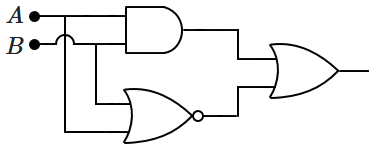
| 1. | AND \((A,B,C)\) | 2. | OR \((A,B,C)\) |
| 3. | NOT \(\bigg(\text{AND }(A,B,C)\bigg)\) | 4. | NOT \(\bigg(\text{OR }(A,B,C)\bigg)\) |

To unlock all the explanations of this course, you need to be enrolled.

To unlock all the explanations of this course, you need to be enrolled.
1. AND
2. OR
3. XOR
4. none of the above

To unlock all the explanations of this course, you need to be enrolled.

To unlock all the explanations of this course, you need to be enrolled.

| 1. | \(A~\text{AND}~B~\text{AND}~C\) | 2. | \((A~\text{AND}~B)~\text{OR}~C\) |
| 3. | \(B~\text{OR}~C\) | 4. | none of these |

To unlock all the explanations of this course, you need to be enrolled.

To unlock all the explanations of this course, you need to be enrolled.
| \(A\) | \(B\) | \(C\) | \(Y\) (Output) |
| \(1\) | \(X\) | \(1\) | \(1\) |
| \(0\) | \(1\) | \(X\) | \(1\) |
| All other cases | \(0\) | ||
| 1. |  |
| 2. |  |
| 3. |  |
| 4. |  |

To unlock all the explanations of this course, you need to be enrolled.

To unlock all the explanations of this course, you need to be enrolled.

| 1. | \(A\) | 2. | \(B\) |
| 3. | \(A~\text{or}~B\) | 4. | NOT \((A)\) |

To unlock all the explanations of this course, you need to be enrolled.

To unlock all the explanations of this course, you need to be enrolled.

| 1. | (\(A\) AND \(B\)) | 2. | (\(A\) OR \(B\)) |
| 3. | (\(B\) OR \(C\)) | 4. | none of the above |

To unlock all the explanations of this course, you need to be enrolled.

To unlock all the explanations of this course, you need to be enrolled.

| 1. | \(A\) AND \(B\) | 2. | \(A\) OR \(B\) |
| 3. | \(A\) | 4. | \(B\) |

To unlock all the explanations of this course, you need to be enrolled.

To unlock all the explanations of this course, you need to be enrolled.
| 1. |  |
| 2. |  |
| 3. |  |
| 4. |  |

To unlock all the explanations of this course, you need to be enrolled.

To unlock all the explanations of this course, you need to be enrolled.

1. \(A\) AND \(C\)
2. \(A\) OR \(C\)
3. always TRUE
4. always FALSE

To unlock all the explanations of this course, you need to be enrolled.

To unlock all the explanations of this course, you need to be enrolled.

1. \(B\) AND \(C\)
2. \(B\) OR \(C\)
3. \(B\)
4. \(C\)

To unlock all the explanations of this course, you need to be enrolled.

To unlock all the explanations of this course, you need to be enrolled.






